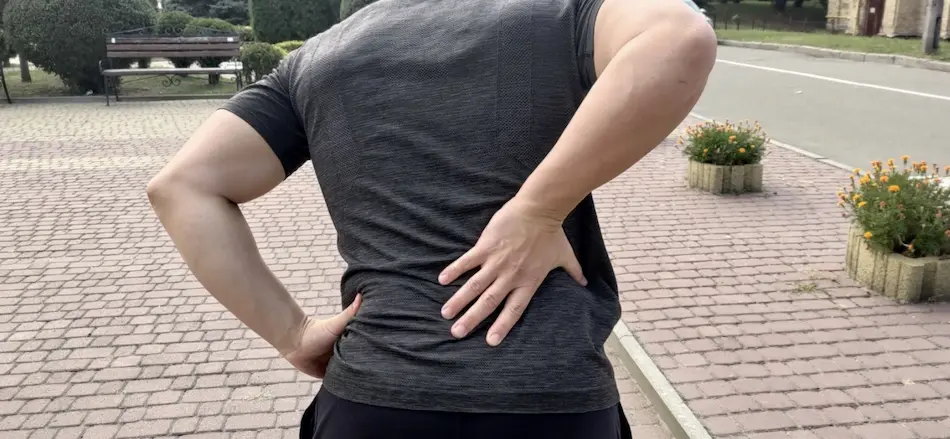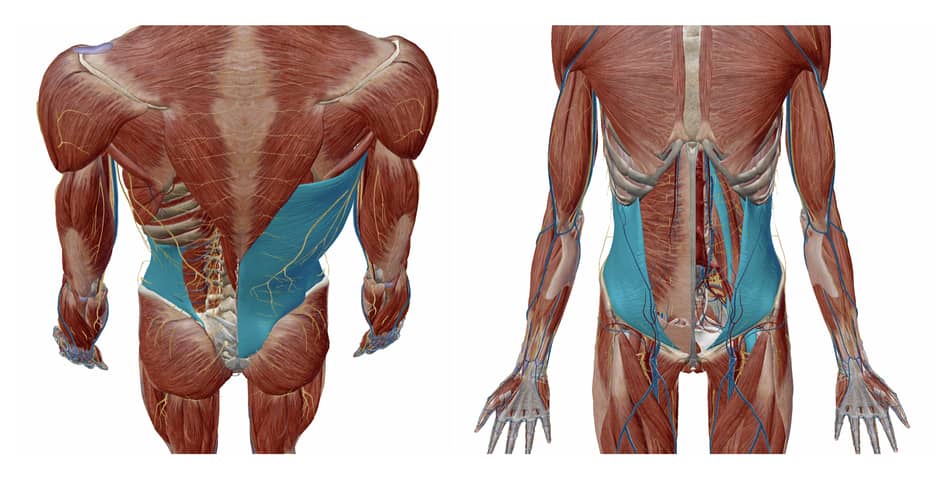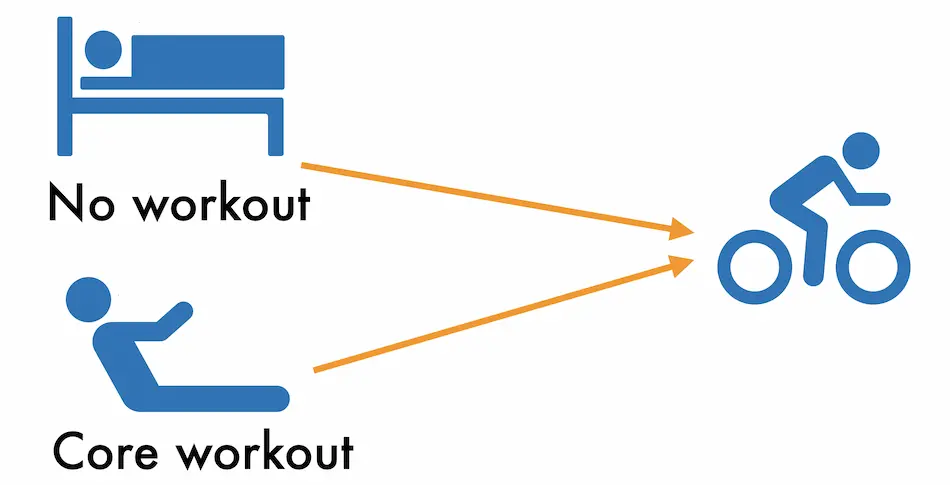Over 23 million cyclists in the United State alone develop some type of overuse injury in their lifetime (lower back pain is the most frequent).
The peloton is no different.

Key Takeaways
- A peloton can cause back pain due to muscular fatigue after a prolonged flexed position.
- During the cycling classes, the body adapts to various positions to maintain optimal force, cadence, and efficiency.
- Over time, the lumbar spine flexion can lead to muscle tension.
- Lower back pain from riding a peloton is often something you can fix almost immediately, however you need to know where is the cause of the problem.
Keep reading if you wanna know how to find the cause and learn what you can do to prevent it from happening again.
Overview
Using a peloton bike can be either therapeutic or detrimental to your lower back. Everything depends on how much and how often you use it.
For example.
- The advanced workouts tend to have higher intensity and require staying longer in uncomfortable positions.
- The longer endurance rides are more taxing on the body compared to shorter peloton recovery rides or interval rides).
- In general, people who have weak core musculature can develop low back pain quicker, regardless of the class type and duration they do.
- The setup of the bike (correctly positioned seat and handlebar can save you a lot of problems. For most of my clients who use peloton with knee pain, this is the first thing on the checklist).
Top reasons why your back can hurt after the peloton
In general, the peloton is not bad for your back, as long as you match the class duration to your fitness level, and your bike has the correct setup of a saddle.
On the flip side, if you have poor core strength and choose rides that are too long (or too intense) it can overload the muscles, cause muscle fatigue and develop trigger points.
Let’s have a look at the most common reasons why a peloton bike can hurt your lower back, and (most importantly) what you can do about it.
1. Core strength and stability
In a nutshell.
- Prolonged cycling can fatigue core muscles
- That usually happens with people who are new to cycling and they want to get their results as fast as possible.
- Instead of starting slowly (and spending extra time on developing core strength), they dive straight into the hardest peloton classes and longest rides.
The core muscle’s job is to maintain stability while riding the bike. There is a lot of hip and knee flexion during the rides that cause your pelvis to move laterally.
This movement is firing up several lower back and core musculature to maintain an efficient position.
People who rarely train their core muscles and pick peloton rides that burn the most calories will likely exhaust all those core muscles responsible for lateral stabilization the trunk, before the class is finish.

Not only that.
- Core muscle fatigue can lead to altered cycling biomechanics, which might increase the risk of injury.
- This means when you get tired, the body starts bouncing from side to side and fails to maintain a stable position.
Case study
John Abt, Ph.D., a researcher from Texas, conducted a study on 15 cyclists who underwent two exhaustive cycling protocol tests (going all out) with and without a prior core workout (Abt et al. 2007).
- The first test was done after the strenuous core workout that led to muscle fatigue.
- This way the researchers could assess how exhausted core muscles affect the body biomechanics, position, and ability to maintain good posture during the ride.
- The second test was done without the core workout.
- Here the cyclists had full energy and their muscles weren’t already tired before even the test started.

Results
In the table below, you can see how having exhausted core muscles affect the stability of the knees, hips, and ankles.
| With core workout | Without core workout | |
|---|---|---|
| Frontal plane knee motion | 23.3 degrees | 15.1 degrees |
| Sagittal plane knee motion | 79.3 degrees | 69.9 degrees |
| Sagittal plane ankle motion | 43.0 degrees | 29.0 degrees |
(A higher degree of joint motion corresponds to lower stability and poor balance.)
Key Takeaways
Prolonged cycling with fatigued core muscles (whenever that’s weak core or physically exhausted) leads to:
- Unstable position during cycling
- Higher body compensation
- Increased risk of injury
What do experts say?
Carlos Rivera, M.D., a physician from Campbell Clinic Orthopedics, says that “core strengthening exercises should be incorporated in any workout program”.
“People who use endurance sport as their main form of exercise should add core exercises, mainly to prevent imbalances or deficiencies in the core muscles,” says Dr. Riviera.
“Having a weak abdominal muscles can result in increased fatigue, decreased endurance, and higher injury rate in runners,” says Dr. Riviera.
My thoughts
To be frank, I don’t spend too much time on core classes. I do a lot of squats, deadlifts, and pull-ups with a heavy load, which means I need to keep my core engaged all the time.
However, if I would not do regular strength training, I would definitely spend more time on the mat.
If your main form of exercise is cycling or running, I strongly recommend you add some core-specific workouts.
What to do?
You can improve core strength by doing some of the best peloton classes for back pain, which will work on muscle endurance and allow for greater alignment of the body during the longer rides.
If you’re not comfortable with advanced core programs, you can also try some of the best peloton pilates classes that are suited for beginners.
People who spend time off the bike to strengthen their core muscles can maintain a good position even for an extended duration of time.
Also, please remember that incorrect position and weak core muscles can lead to extensive lumbar flexion, which can then result in sciatica pain.
I’ve already written an article about the peloton for sciatica, which I suggest you have a look at.
2. Seat position
Another, and probably the most common reason why people develop lower back pain is due to incorrect seat position.
The seat position will dictate how much your hips will rock to fully perform the pedal stroke.
Case study
A fascinating study done by (Salai, et al. 1999) showed that a 10° to 15° change in the saddle eliminated lower back pain in 29 of 40 cyclists of the time 6 months.
- This means just a slight difference in the saddle will have a massive impact on the biomechanics of the body.
- This also means that incidence of back pain while doing peloton class can be significantly reduced simply by appropriate adjustment of the seat and the angle of the saddle.
Key Takeaways
In general, your back hurt when using the peloton likely because of the inappropriate seat position and saddle angle.
Having a seat too high, too low, too far back, or even too close to the handlebar will place them back in either flexed or compressed position.
How to adjust Peloton for back pain
Here is the video tutorial you can find the basic guidelines for adjusting the peloton bike seat. This can help to avoid or minimize pressure on the spine and low back pain.
If the seat is too high this means your foot can struggle to reach the bottom of the stroke, the pelvis drops down on one side and then immediately rock to the other side.
This motion from side to side puts an enormous amount of pressure on the stabilizing muscles and can fatigue low back muscles.
- Stand next to the bike to adjust the seat.
- Your seat height should be around your hip bone level. This will allow you to extend your knee by around 15-20 degrees.
- This will also help to engage the glutes and reduce pressure on the knee cap.
- Hop on the bike and do some revolutions to assess how it feels.
- Once you find the right height, mark it down for future reference.
If the seat is too far back this will force your leg to reach further and cause the pelvis to rock side to side.
Also, having a seat too far back forces the lumbar spine to be in the prolonged flex position, which leads to overactivation of low back extensors and prolonged muscle tension.
- Bend your arm in your elbow at 90 degrees and position your elbow in front of your seat.
- Keep your palm open with your fingers pointing forward.
- Your hand should be able to reach comfortably to the handlebar.
- The seat distance should be right in the middle where your knee doesn’t go over the pedals and you cycle.
3. Limited range of motion
Apart from the aforementioned seat position and weak core stability, it can also be a restriction on the hip range of motion.
People who cannot reach full hip flexion at the top of the pedal stroke will cause the body to compensate and force the pelvis to tilt. You can read more about “peloton and hip pain” in my article here.
One easy way to help you determine how stable are your hips during the ride is to record yourself on the camera as you ride.
How to record yourself on the peloton bike
- Set up the phone or camera on the tripod and place it behind you. Placing a camera on the side won’t give you a clear indication of your pelvis lateral movement.
- On the other hand, recording yourself from the back will allow you to see exactly how your hips move.
- Ask someone to stand behind you and record how you ride. This is an alternative if you don’t have a tripod.
- However, the person may fatigue holding the camera so you may not get the complete footage.
- Set up the camera settings for 60 fps or slow motion. Slow motion will allow you to get a more precise view.
- If the footage is too fast it may not show all the details.
- Select a class that is long in duration. This will help you determine your biomechanics.
- If your hips rock side to side only after 30 minutes you have a clear indication that your core muscles get fatigued.
- On the other hand, if you see your hips rock immediately, this may ian ndicate incorrect seat position.
- Be natural. Don’t think about your recording.
- To find the cause you need to perform the class as you normally would. So don’t try to think about keeping your position as stable as possible.
- Wear tight clothes. Wearing clothes that are close to the skin will help to see better movement patterns. Wearing a baggy T-shirt or pants may hide the actual pelvis movement.
NOTE: Your pelvis and hips will always rock in some way or another. The thing you can do that will move the needle the most is strengthen your core muscles (more on that soon).
Mid back pain after Peloton
One of the reasons why you may have mid-back pain after a peloton ride is the handlebar position. Having the handlebar too short or too high can contribute to putting the lumbar spine and its soft tissue under constant load.
This leads to an increase in the curvature in the mid and lower spine, which will translate into muscle tension.
Handlebar too high/seat to close
- Having a handlebar too high or a seat too close to the handlebar will force us to adapt more upright torso position.
- While this may seem like a good solution, over time this will add more compression to the spine and fatigue mid-back muscles.
Handlebar too low
- Having a handlebar too low puts a lot of pressure on the mid and upper back. This correlates with having a seat too high.
- It will force you to reach too far down and overly extend the back, keeping the lumbar spine overly flexed position and fatiguing mid-back muscles.
Here you can see a comprehensive tutorial on how to adjust your bike.
Upper Back Pain After Peloton
If you have upper back pain or neck pain after the peloton ride this means your handlebar is too far away (or your seat is too far back).
When your seat depth is too far back, it will force your arms to reach further and create a kink in your neck.
This can fatigue muscles in the shoulder region and compensate for your neck.
The ideal distance between your seat and the handlebar is the length between your elbow to your fingers.
Here is how you can adjust your seat to eliminate upper back pain.
- Place the elbow at the nose of the seat
- Push the seat forward until your fingertips reach the handlebar
- Make sure to secure the seat position by tightening the adjustment bar
Peloton App Workouts For Back Pain
Once you have an idea why your back hurts after the peloton ride, and you know the correct seat position, now let me show you the best classes you can do to strengthen your core muscles.
Strengthening your core is your number one priority because it will keep your trunk and spine in a more stable position, reduce pressure and minimize back pain.
Peloton has over 15 programs that teach week by week how to strengthen their body, improve flexibility, or even run a marathon.
1. Peloton Strong Core Strong Body
- One of the core programs is called strong core strong body by Irene Schultz.
- This is a 4-week bodyweight program that is purely designed for a cyclist to strengthen their core, improve performance and reduce back pain.
- This program is beginner-friendly, with 6 classes each week that run between 5 to 15 minutes.
- All classes id focused only on working your abdominals and back muscles.
2. Crush Your Core
- As a whole, the peloton crush your core is a 4-week program with pre-scheduled classes, all focused on working the strength and endurance of abdominal muscles.
- 6 sessions per week that last 5 to 15 minutes all designed to work various muscle groups that help your performance and minimize lower back pain.
3. Peloton Pilates
In a nutshell, peloton pilates consists of multiple exercises that focus on muscle endurance by doing a high volume of reps.
Peloton pilates is another great intervention for lower back pain. It has a number of exercises that targets lumbar spine musculature and abdominal muscles.
Conclusion
- Doing peloton rides every day is a great way to lose weight and get into shape.
- However, if you spend too much time on the bike in an inefficient position, your back can start to hurt.
- A simple solution for this complex problem is getting your saddle in the optimal position.
- This will help to minimize muscle tension right off the gate.
- The second option that will work long-term is to focus more effort on your core strength by doing pilates or yoga.
- Alternatively, you can use some of the peloton core workouts that involve pre-made training plans.
